The Foundation of Freedom is the Courage of Ordinary People History  On Line On Line
|
By early January, 1951, China's ambush of our forces who had driven far into North Korea, and their invasion of South Korea, outran their support lines. Simultaneously, our own forces gained strength and established a line below Osan and Wonju, roughly along the 37th Parallel. General Ridgwayassumed command and, in a series of vicious back-and-forth attacks and counter-attacks, recaptured Seoul and established strong defensive positions across Korea. General Ridgway has never been given the credit he deserved for his leadership. Without question he was our greatest fighting Generalin Korea. His military judgment and deployment of available resources are the reasons South Korea is free today. By July, this "Main Line of Resistance (MLR)" became the killing grounds while our governments sought a cease-fire by diplomatic means. |
|
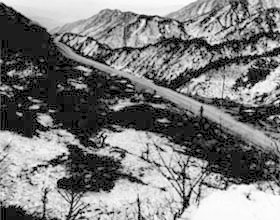 | As 8th Army began to grow strong enough to stop the long Chinese advance, the enemy continued to try and encircle our forward units. To prevent this, General Ridgway found it necessary to abandon Seoul, and fall back still further to a stable Line D. From there, I and IX Corps could begin a coordinated drive to force the Chinese to retreat themselves. In this photo, gunners of Heavy Mortar Co., 32nd Regiment, 7th Division, move into position in a pass between Punggi and Tanyang to take the attacking enemy in defilade. 8 January 1951. |
Pfc. Miles Adair of Leon, Io, (left) and Sgt. Norbert Brzycki of Chicago, Ill., infantrymen of the 5th RCT, dig in on a hill captured from the Chinese overlooking the Han River as our troops continue our counter offensive Operation Thunderbolt. 7 February 1951. | 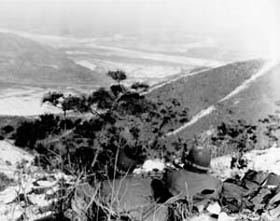 |
 | Waiting for the counterattack. 10 February 1951 These men of the 19th Infantry Regiment, 24th Division, dig in after taking a Chinese-held hill along the Han River as part of the "Ridgway" offensive, about fifteen miles above Ichon and Wonju. A day later, China counter-attacked at Hoengsong, inflicting about 10,000 ROK and 2,000 UN casualties. A horrible massacre, but our UN allies stopped them at Chipyong-ni, and the "Wonju Line" would hold. The photographer who snapped this picture was hit by Chinese fire a few minutes later. |
Early in Ridgway's Operation "Operation Killer", I Corps is advancing back to the Han. 22 February, 1951 Although suffering from severe neck and face wounds as a result of an exploding Chinese grenade, Company F CO braces himself upright between two jeeps and refuses to leave until he has finished directing first aid treatment and evacuation of wounded men of his company. Captain J. W. Finley of Hazelhurst, Ga., Co. F, 5th Cavalry Regiment, 1st Cavalry Division. A Company Commander worthy of his men. | 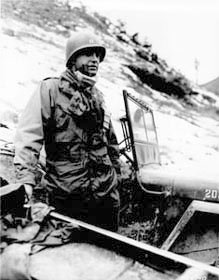 |
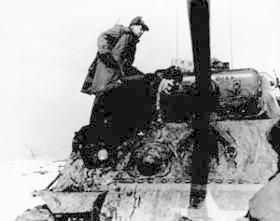 | 7 March, 1951. Having stopped the latest Chinese counter attack and resupplied our own troops, General Ridgway launched Operation Ripper. The enemy had become overextended and Ridgway wanted to further weaken them by locating and destroying their advanced forces and equipment, and prevent any attempts to re-take the offensive. In this photo, a soldier of the 35th Regiment, 25th U.S. Infantry Division, goes aboard a tank to be evacuated to rear areas after he was wounded by mortar fire. |
As Operation Ripper begins, men of Co. K, 35th RCT, 25th Division, fire an M1919A4 .30 Caliber light machine gun in support of a rifle platoon attacking Chinese north of the Han River, 7 March 1951. | 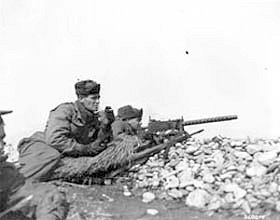 |
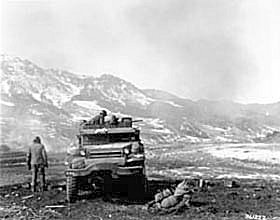 | Battery B, 15th AAA Battalion, 7th Infantry Division, fires quadruple .50 caliber machine guns from an M-16 at Chinese Communist-held positions, as 3rd Battalion, 32nd RCT, 7th Inf. Div., prepares to attack north of Chae-jae. 12 March 1951.
|
We recaptured Seoul on March 18, and pressed on. Here, 15th RCT, 3rd Infantry Division, attacks Chinese positions on a hill near the village of Uijong-bu. 23 March 1951.
| 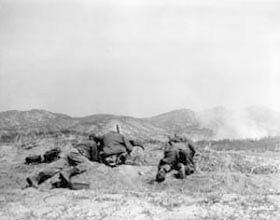 |
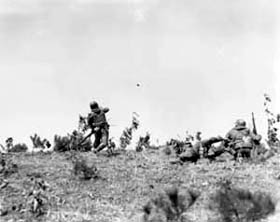 | Lieutenant Ralph Barnes of Arlington, Va., platoon leader, 1st Platoon, Co. C, 15th Infantry Regiment, 3rd Infantry Division, throws a hand grenade at Chinese positions, as UN troops press an attack near Uijong-Bu. 23 March 1951.
|
Pfc. Jack Lee of Wichita, Kan. (left), and Cpl. Joseph W. Thomas of Honolulu, T.H., fire their light machine gun on Communist positions as United Nations forces attack a hill, three miles south of the 38th Parallel. 31 March 1951. | 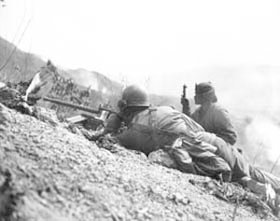 |
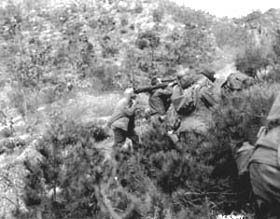 | A 57-mm recoilless rifle team opens fire at a Chinese position three miles south of the 38th Parallel. 31 March 1951. |
Tractors of the 196th Field Artillery, U.S. Eighth Army, pull 155-mm guns through a detour near the town of Tari-Gol in their advance towards the 38th Parallel. 8 April 1951. | 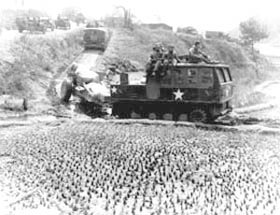 |
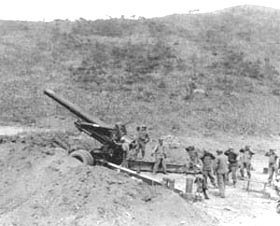 | Men of Battery A, 17th Field Artillery Battalion, EUSAK, cover their ears as unit leader gives the signal for firing the 8-inch howitzer, north of Chunchon. 9 April 1951.
|
On the day President Truman ordered immediate change of command from General MacArthur to General Ridgway, with severe fighting still ahead against an aggressive enemy, our Army's mission started to become establishing a defensive line across Korea at approximately the old 38th Parallel border, and letting the diplomats try to obtain a Cease-Fire. In this photo, men of the 3rd U.S. Rangers, 3rd Infantry Division, spearhead our advance north of the Imjin River across the 38th Parallel while under heavy Chinese mortar fire. 11 April 1951. | 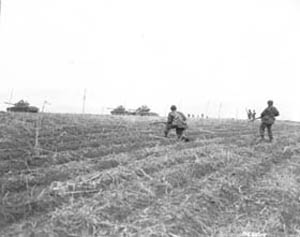 |
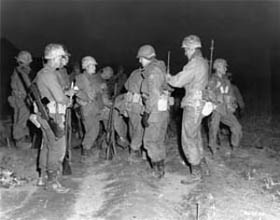 | As high command changed hands, and political figures around the world tried to stop the fighting by diplomatic means without starting WWIII, men of the 3rd Ranger Company, 3rd Infantry Division, adjust their gear before undertaking a dawn patrol across the Imjin River, Korea. 17 April 1951. |
A squad of the 3rd Ranger Co., 3rd Infantry Division, moves out of assembly area to probe Chinese Communist territory north of the Imjin River, Korea. 17 April 1951.
|  |
 | Cpl. Thomas E. Bullis of Troy, N.Y., gunner, and Pfc. Charles R. Gilman of Peroria, Ill., assistant gunner, fire their 57-mm recoilless rifle at a Chinese Communist pillbox start of the Chinese Spring Offensive. Bottom of Hill 860, near Kaoch/Eang-ni. 24 April 1951.
|
A M1919A6 machine gun crew gives supporting fire to UN troops as they withdrew from Hill 412 south of the Imjin River after a fierce battle with Communist-led Chinese forces. 26 April 1951. |  |
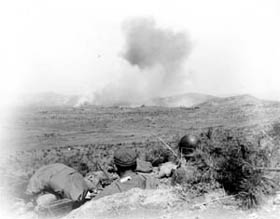 | Chinese Communist fortifications and camouflage used to prvent aerial detection. April 1951.
|
Dust and smoke rise after an 8-inch howitzer of the 96th Field Artillery Battalion, X Corps, let loose with a 200-lb projectile along the central Korean front. 6 May 1951.
| 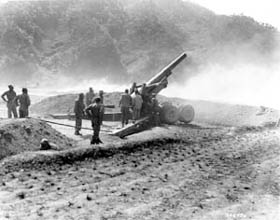 |
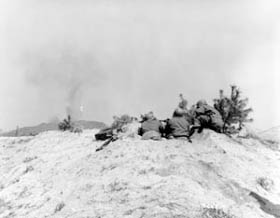 | A .50 caliber machine gun gives covering fire for Greek troops of the 7th Cavalry Regiment, 1st Cavalry Division, as they advance on a Communist-held position north of Uijongbu, Korea. 9 May 1951. |
155-mm howitzers of the 82nd Field Artillery Battalion, 1st Cavalry Division, made the Communist keep their distance by pouring shells into their lines from the backyard of the Capitol Building, Seoul, Korea. 20 May 1951. | 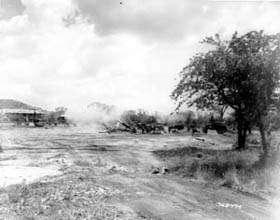 |
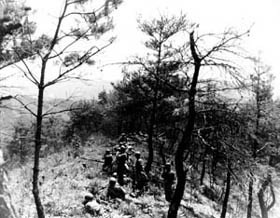 | Men of Company "A", 31st Infantry Regiment, 7th U.S. Infantry Division, fire from 57-mm recoilless rifles and .30 caliber machine guns on the Communist-held Hill 257, near T'Omok-Kol. 24 May 1951.
|
Their drive to the 38th Parallel stalled temporarily, men of the 3rd Division Reconnaissance Company dig in for the night on the east central front. 28 May 1951.
| 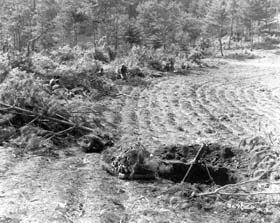 |
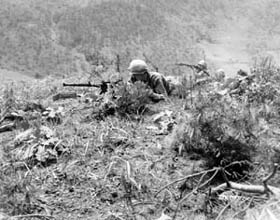 | Two light machine gunners cover men of the 187th RCT as they go up a ridge on Hill 451, north of Inje while F-80's strafe the village. 1 June 1951. |
A gun crew from Company "A", 90th Field Artillery Battalion, 24th U.S. Infantry Division, fires a 155-mm howitzer at Communist positions in the Kojongchon sector, eight miles above the 38th Parallel. 3 June 1951. | 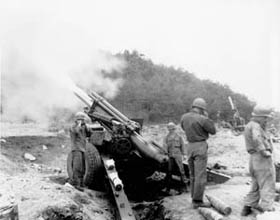 |
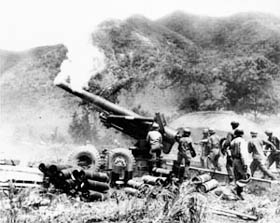 | Cannoneers of Battery A, 17th Field Artillery Battalion, U.S. Eighth Army, Reload their 8-inch howitzer after firing on Chinese Communist positions in support of infantry units south of Chorwon. 10 June 1951.
|
A wounded man of the 17th Infantry Regiment, 7th Division, is evacuated from Hill 657 near Sanghoenchon, Korea, after having been hit by a grenade.11 June 1951. | 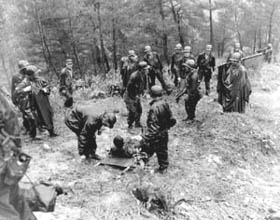 |
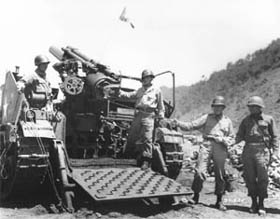 | Lt. Gen. William M. Hoge, Commanding General, U.S. IX Corps, left, holds the lanyard which will fire the 75,000th shell to be fired by the corps since the start of the conflict in Korea. Brig. Gen. William N. Gillmore, Commanding General, Corps Artilllery, stands to the right of General Hoge. This day also marked the end of the first year fighting in Korea.25 June 1951.
|
An 8-inch howitzer crew of Battery A, 96th Field Artillery Battalion, fires in support of ROK forces near Yanggu, site of nine of the bloodiest battles in the war. 25 June 1951. | 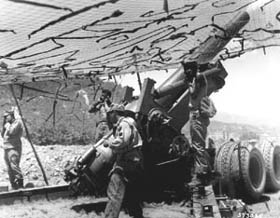 |
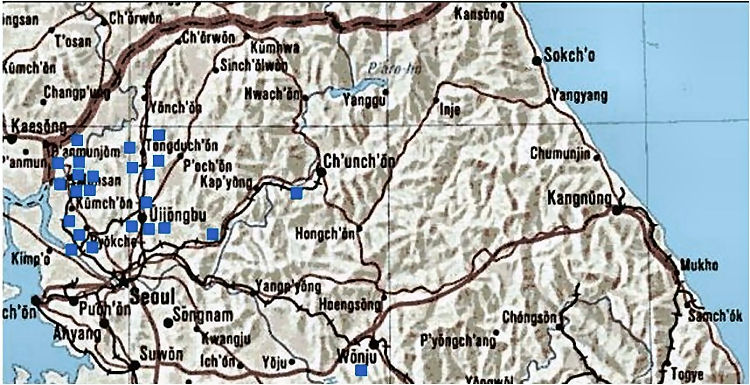
July 1, 2011: The Border. (The little blue squares are US Army Camps)
(The Horizontal line is the 38th parallel, the border at the start of the North Korean invasion.) |
During its first year, the war raged across entire Korea, from the southern tip at Pusan to the Yalu River. Desperate refugees were swept back and forth with it like flocks of birds in a forest fire. On July 1, 1951, almost two years of slaughter still lay ahead. But on that day, and the sixty years since, the border was about where the slaughter began, about where it would finally end.
|
|
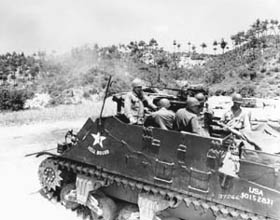 | A 105-mm self-propelled howitzer, manned by five soldiers from Cody, Wyo., speeds another projectile into Red lines. The men, all Cannoneers in B Battery, 300th Armored Field Artillery battalion X Corps, are (L-R); Sergeant First Classs Allen J. Helms, Chief of Section; Corporal Joseph Stair, Gunner; Sergeant Richard N. Null, Lanyard Man; Corporal Robert C. Smith, Cannoner. 1 July 1951 |
Hit in the back during a grenade duel, Corporal Dominick F. Zegarelli, (Utica, N.Y.) Company L, 7th Regimental Combat Team, U.S. 3rd Infantry Division, waits for evacuation, while other members of his platoon rest. 3 July 1951.
From a Military family, Corporal Zegarelli died in 1957 as a result of his wounds. |  |
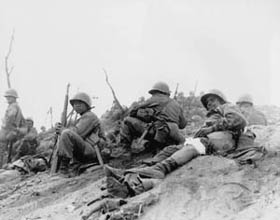 | Cpl. Sam Ayala of Niles, Calif., Co. L, 7th RCT, U.S.3rd Infantry Division, waits for medical evacuation from Hill 717, Cpl. Ayala was wounded while engaged in a bitter grenade battle with deeply entrenched Chinese troops.3 July 1951.
|
Company "M", 7th RCT, U.S. 3rd Infantry Division machine gunners, watch for the movements of Communists forces, as artillery lands on Hill 717, one of the objectives of "Operation Doughnut". 3 July 1951. |  |
 | Returning from an assault on Hill 717, men of Company "L", 7th RCT, 3rd Infantry Division, help a wounded buddy onto a strecher for evacuation to an aid station. 3 July 1951.
|
Sgt. Douglas D. Tompkins of Jud, North Dakota, Tank Company, 5th RCT, 24th U.S. Infantry Division, fires a .50 caliber machine gun at Communist-held positions during an assault against the Chinese along the east central front. 14 July 1951. Note the smoke marking his position. Although the NK had smokeless powder, we did not, an incredible error of military leadership which cost us many casualties in this miserable war. | 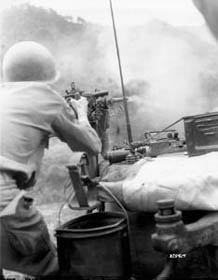 |
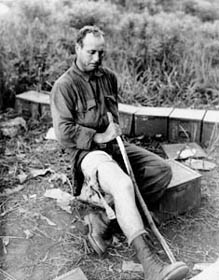 | 1st Lt. Dowll Hudson, Co. C, 1st Battalion, 38th Infantry Regiment, stops to rest on his way to the aid station. With pain in his face after a six-hour walk on a wounded leg, Lt. Hudson refused a strecher because "others need it worse than I". Hw was wounded in the attack on Hill 1171. 26 July 1951. Korea. |
Cpl. Bill Miller of Trenton, New Jersey, and Sgy. Clifford Meli of Jamestown, New York, members of Company "M", Heavy Weapons, attached to Company "I", 5th RCT, 24th U.S. Infantry Division, blast Communist-held positions from their .50 caliber machine gun post, during action against the Chinese Communist forces, near Chiper-ri. 3 August 1951.
| 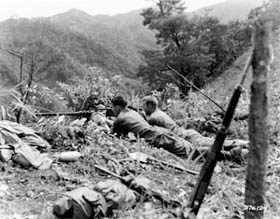 |
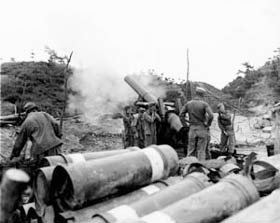 | An 8-inch howitzer of Battery B, 720th Field Artillery Battalion, U.S. X Corps, fires at the Chinese Communists near Yanggu, Korea, in support of the 36th Regiment, 5th ROK Infantry Division. 21 August 1951. |
Men of Battery C, 936th Field Artillery Battalion, U.S. Eighth Army, fire the 100,001st and 100,002d shell at Chinese Communist position near Choriwon. 10 October 1951.
| 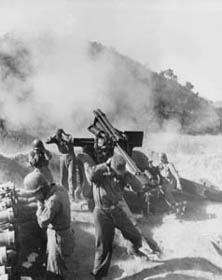 |
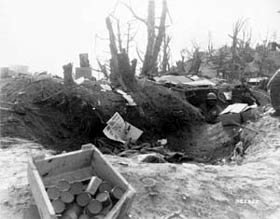 | Showing the entrance to his bunker at the edge of crater caused by an enemy mortar shell is Corporal George C. Brown, Boston, Massachusetts, Company L, 3rd Battalion, 7th Cavalry Regiment, 1st U.S. Cavalry Division.17 October 1951. |
Powder smoke and dust billow as a recoilless rifle team of Co. D, 7th infantry Regiment, 3rd U.S. Infantry Division, fire their weapon at Chinese Communist positition on Hill 200 near Qnmong-Myon. 9 November 1951.
| 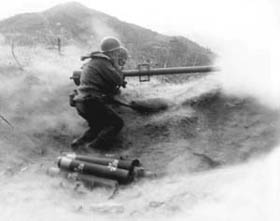 |
Causes of the Korean Tragedy ... Failure of Leadership, Intelligence and Preparation
The Foundations of Freedom are the Courage of Ordinary People and Quality of our Arms
Back to: South To The Naktong, North To The Yalu |











































